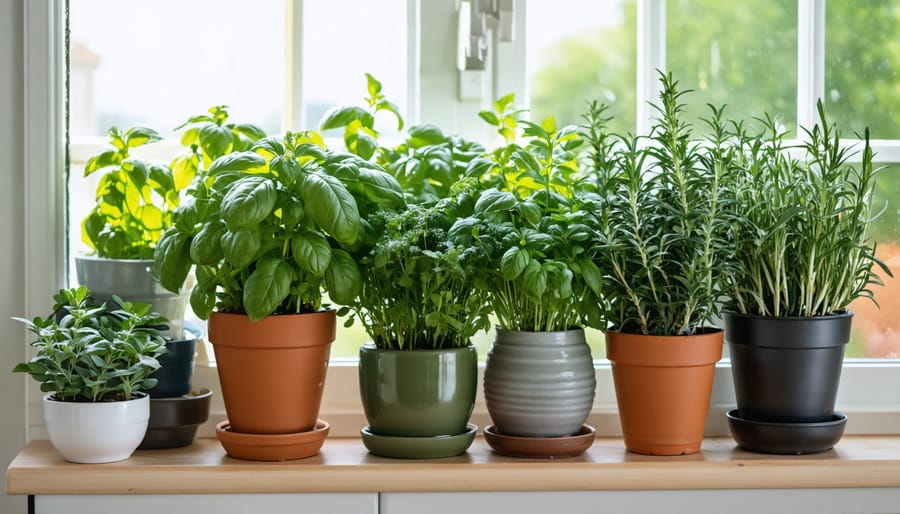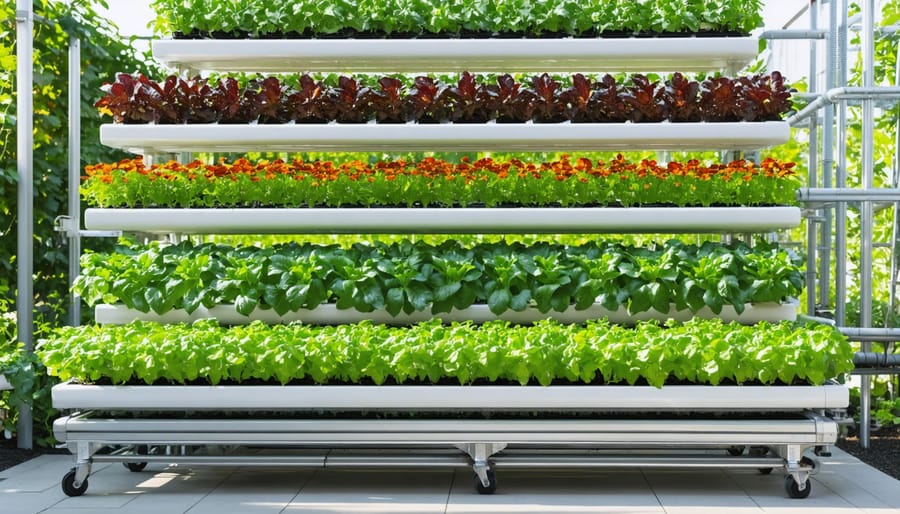Transform your windowsill, balcony, or patio into a thriving herb oasis with essential container gardening basics. Select deep, well-draining pots at least 6 inches wide for most culinary herbs, grouping varieties with similar water needs together. Mediterranean herbs like basil, rosemary, and thyme flourish in terracotta containers, while mint and parsley thrive in moisture-retaining plastic pots. Position containers where herbs receive 6-8 hours of direct sunlight daily, rotating them weekly to ensure even growth. Fill with premium organic potting mix enhanced with perlite for optimal drainage and root development, leaving one inch of space below the rim for efficient watering. This space-saving gardening method delivers fresh herbs year-round while offering complete control over soil quality, moisture levels, and plant nutrition – perfect for urban gardeners and cooking enthusiasts alike.
Best Herbs for Container Growing
Easy-to-Grow Starter Herbs
Getting started with urban herb gardening is easier than you might think, especially when you begin with these foolproof herbs. Basil is a fantastic first choice – it grows quickly, produces abundantly, and adds fresh flavor to countless dishes. Simply place it in a sunny spot, keep the soil consistently moist, and pinch off the top leaves regularly to encourage bushier growth.
Mint is another beginner-friendly herb that practically grows itself. In fact, it’s so vigorous that it’s better suited to container growing than garden beds, where it can become invasive. Choose a medium-sized pot with good drainage, and you’ll have fresh mint for tea and cocktails all season long.
Parsley is equally forgiving and offers both flat-leaf and curly varieties. While it takes a bit longer to germinate, once established, it provides consistent harvests and handles partial shade better than many other herbs. It’s also rich in vitamins and makes a beautiful garnish.
Other easy-to-grow options include chives, which return year after year and produce pretty purple flowers, and oregano, which thrives in containers and doesn’t need much attention beyond occasional watering. These starter herbs not only build your gardening confidence but also provide fresh flavors for your kitchen throughout the growing season.
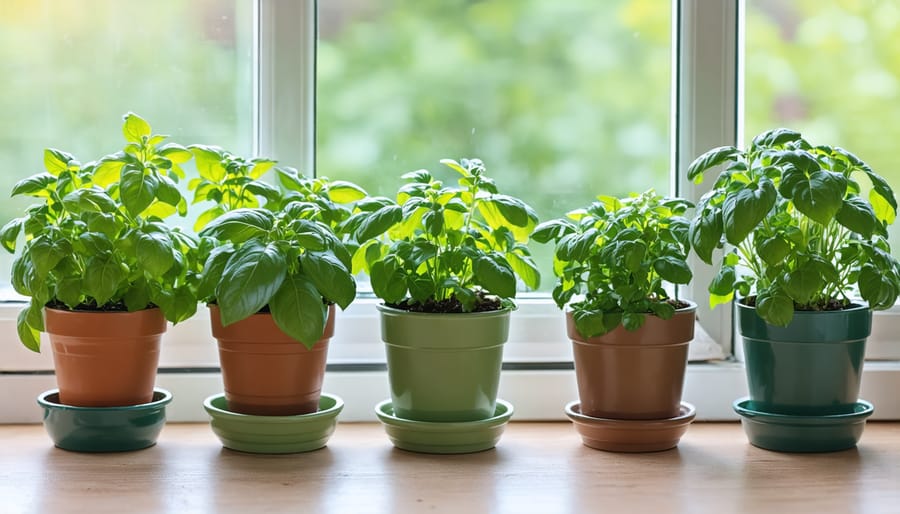
Advanced Herb Options
While many herbs are easy to grow, some varieties require a bit more attention to truly thrive in containers. Rosemary, for instance, needs excellent drainage and bright sunlight to flourish. Use a terra cotta pot with plenty of drainage holes, and mix some gravel into your potting soil to prevent root rot. During winter, bring your rosemary indoors and place it in a sunny window, but keep it away from heating vents that can dry it out.
Thyme is another Mediterranean herb that demands specific care. It prefers lean soil, so avoid rich composts or frequent fertilizing. The key is to water only when the soil feels dry to the touch – thyme would rather be too dry than too wet. Trim it regularly to prevent woody growth and encourage bushier plants.
Sage presents its own unique challenges but rewards careful gardeners with beautiful, fragrant foliage. Plant it in a deep container to accommodate its extensive root system, and ensure good air circulation to prevent powdery mildew. Like its Mediterranean cousins, sage prefers well-draining soil and full sun. Prune it back in early spring to maintain its shape and promote healthy growth.
For all these herbs, remember that less is often more when it comes to watering and feeding. They’ve evolved to thrive in challenging conditions, and too much care can actually harm them.
Container Selection and Setup
Container Types and Sizes
Selecting the right container is crucial for successful herb gardening, especially when growing in small spaces. Terra cotta pots are a popular choice, offering excellent drainage and a classic look, though they can dry out quickly in hot weather. Plastic containers are lightweight and affordable, making them perfect for beginners, while ceramic pots provide both functionality and aesthetic appeal.
For most herbs, choose containers at least 6 inches deep with adequate drainage holes. Basil, parsley, and cilantro thrive in 8-inch pots, while larger herbs like rosemary and sage need 12-inch containers to accommodate their root systems. Mint should always have its own container, as it tends to spread aggressively.
When it comes to materials, consider your climate and maintenance preferences. Wooden containers offer natural insulation but require more upkeep to prevent rot. Metal containers look modern but can heat up quickly in direct sun, potentially damaging herb roots. Self-watering containers are excellent for busy gardeners, helping maintain consistent moisture levels.
For small windowsill herbs like thyme and oregano, 4-6 inch pots work well. If you’re planning an indoor herb garden, ensure your containers have saucers to catch water drainage. Remember that grouping herbs with similar water needs in the same container can simplify care, but allow enough space between plants for good air circulation and growth. Dark-colored containers absorb more heat, which can be beneficial in cooler climates but might require more frequent watering in warm regions.
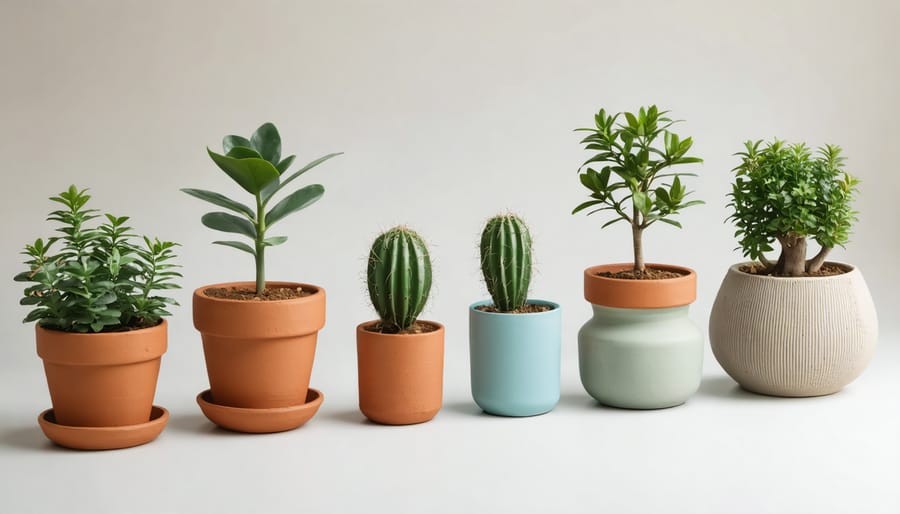
Soil and Drainage Requirements
The success of your container herb garden largely depends on getting the soil mix and drainage just right. Unlike garden soil, which is too heavy for containers, herbs thrive in a well-draining potting mix that provides both nutrients and proper aeration. A good DIY mix consists of equal parts quality potting soil, perlite, and compost. This combination ensures your herbs get the perfect balance of moisture retention and drainage they need.
When it comes to drainage, it’s absolutely essential to have holes in the bottom of your containers. Most herbs hate having “wet feet,” which can lead to root rot. Make sure your containers have at least 2-3 drainage holes, and consider adding a layer of small stones or broken pottery pieces at the bottom to improve water flow. If you’re using decorative pots without drainage holes, simply place your herbs in plastic containers with holes inside them.
The depth of your soil matters too. Most herbs need at least 6-8 inches of soil depth for healthy root development. Mediterranean herbs like rosemary and thyme can manage with slightly less, while larger herbs like sage and oregano appreciate more room to grow. Remember to leave about an inch of space between the soil surface and the container rim for watering.
Testing soil drainage is simple – after watering thoroughly, the pot should drain within 30 minutes. If water sits on top or takes longer to drain, your mix needs more aerating materials like perlite or coarse sand. Regularly check the soil moisture by sticking your finger about an inch deep – if it feels dry at that depth, it’s time to water.
Caring for Container Herbs
Watering and Feeding
Proper watering and feeding are crucial for thriving container herbs. Unlike plants in the ground, containerized herbs rely entirely on you for their water and nutrient needs. Following these container maintenance tips will help your herbs flourish throughout the growing season.
For watering, the golden rule is to check your herbs daily. Stick your finger about an inch into the soil – if it feels dry, it’s time to water. Always water thoroughly until you see it draining from the bottom of the pot, but avoid letting your herbs sit in standing water. Different herbs have varying water needs – Mediterranean herbs like rosemary and thyme prefer drier conditions, while basil and parsley enjoy consistently moist soil.
When it comes to feeding, herbs generally don’t need heavy fertilization. Too much feeding can actually reduce their flavor and aroma. Apply a balanced, water-soluble organic fertilizer at half strength every 4-6 weeks during the growing season. If you notice yellowing leaves or stunted growth, this might indicate your herbs need a nutrient boost.
For the best results, water in the morning to allow excess moisture to evaporate throughout the day. This helps prevent fungal issues that can develop in consistently wet conditions. During hot summer months, you may need to water twice daily, especially if your containers are in full sun. Consider using self-watering containers or water-retaining crystals to help maintain consistent moisture levels, particularly if you’re away from home frequently.
Pruning and Harvesting
Regular pruning and harvesting are essential for keeping your container herbs healthy and productive. The best time to harvest most herbs is in the morning after the dew has dried but before the day gets too warm. This is when their essential oils are most concentrated, giving you the best flavor.
To harvest leafy herbs like basil, mint, and parsley, pinch or cut stems just above a set of growing leaves. This encourages bushier growth and prevents the plants from becoming leggy. For woody herbs like rosemary and thyme, clip the stems back by no more than one-third of the plant’s total height to maintain their shape and promote new growth.
Never remove more than one-third of the plant at once, as this can stress the herb and slow its recovery. When harvesting individual leaves, choose the larger, mature ones and leave the smaller ones to continue growing. For herbs grown for their flowers, such as lavender, cut the stems just as the buds begin to open.
Regular pruning helps prevent flowering in herbs like basil and cilantro, which can make the leaves bitter. If you notice flower buds forming, pinch them off immediately. This process, known as deadheading, redirects the plant’s energy back into leaf production.
For winter use, consider harvesting larger quantities in late summer or early fall. You can dry herbs by hanging bundles upside down in a warm, dry place, or freeze them in ice cube trays with water or oil for later use. Remember to clean your pruning tools between uses to prevent the spread of disease.
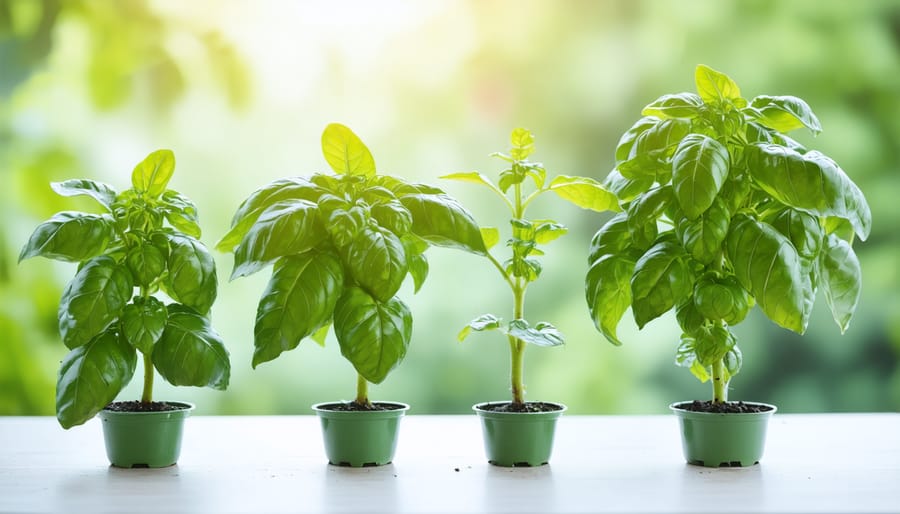
Common Problems and Solutions
Even experienced gardeners face challenges with container herbs, but most common problems have simple solutions. If your herbs are wilting despite regular watering, check for proper drainage – roots sitting in water can lead to rot. Simply drill additional holes in your container or add a layer of gravel at the bottom to improve drainage.
Yellowing leaves often indicate either overwatering or nutrient deficiency. Cut back on watering frequency and ensure your containers have good drainage. If the problem persists, feed your herbs with an organic, balanced fertilizer every few weeks during the growing season.
Leggy, sparse growth typically means your herbs aren’t getting enough light. Most herbs need 6-8 hours of direct sunlight daily. Try moving containers to a sunnier spot or consider using grow lights during darker months.
Pest problems like aphids or spider mites can be managed naturally by spraying plants with a mixture of mild dish soap and water. For preventive care, regularly inspect your herbs and maintain good air circulation between plants.
Brown, crispy leaves usually signal underwatering or too much direct sun. Water more frequently during hot weather and consider providing afternoon shade for sensitive herbs. Remember that containers dry out faster than garden soil, especially terra cotta pots.
If your herbs stop growing or produce fewer leaves, they might be root-bound. Repot them into larger containers with fresh potting soil to give roots more space to expand.
Growing herbs in containers is not just a practical way to have fresh flavors at your fingertips – it’s a rewarding journey that connects you with nature right outside your door. As we’ve explored throughout this guide, container gardening offers incredible flexibility, whether you’re working with a sunny windowsill or a spacious patio.
Remember that success with container herbs comes down to a few key principles: choosing the right containers with proper drainage, using well-draining potting mix, providing adequate sunlight, and maintaining consistent watering practices. Don’t be afraid to experiment with different herb combinations and container arrangements to find what works best in your space.
Starting your herb container garden doesn’t require a significant investment or extensive gardening experience. Begin with a few hardy herbs like basil, mint, or thyme, and expand your collection as your confidence grows. The satisfaction of snipping fresh herbs for your cooking and watching your plants thrive under your care is truly unmatched.
We encourage you to take the first step today. Start small, learn from experience, and most importantly, enjoy the process. Your container herb garden will not only enhance your cooking but also bring a touch of natural beauty and fragrance to your living space. Happy gardening, and may your herbs grow abundantly!

